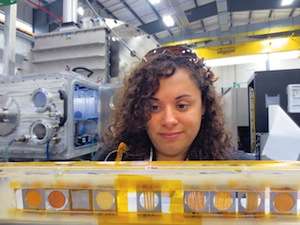How waste wood works for forests

At first glance, they may look lush and green, but many of the nation's forests also are chock-full of brush—often, invasive species and disease-transmitting biomass—just waiting for a spark. "One of the reasons wildfires are so catastrophic is that many forests are unhealthy and there's a lot of excess biomass in the forest," says Joseph Jakes. "By creating new and expanded markets for the low-value biomass, we aim to provide economic incentives for people to come in and selectively remove the hazardous biomass—which will simultaneously accelerate forest restoration and create jobs in the U.S. forest products industry."
A materials research engineer at the U.S. Forest Products Laboratory in Madison, Jakes (BSChE '05, MSMSP '07, PhDMS&E '10) is using advanced research tools to extend the value of that "waste" wood—for example, in developing more effective bio-derived adhesives for engineered products such as plywood or particle board.
When "glued" wood gets wet, it swells and causes adhesive bonds to fail. In collaboration with Materials Science and Engineering Professor Don Stone and PhD student Nayomi Plaza, Jakes is studying, at the cellular level, how those failures occur.
One challenge is that researchers still do not have a clear understanding of the nanostructure of wood. "It's a very old problem, but there are new techniques for looking at it," says Stone.
Jakes himself has developed nanoindentation methods that allow researchers to measure the mechanical properties of individual wood cell walls. And working at Argonne National Laboratory, he developed advanced microscopy techniques that allow him to correlate changes in mechanical properties with the amount of adhesive infiltration at the cell-wall level.
He and Plaza have created unique actuators that allow them to study moisture-induced swelling forces where adhesives bond to wood cells. Plaza is conducting research at Oak Ridge National Laboratory, where she has developed methods and customized tools that enable her to use neutron scattering to study how unmodified and modified wood swells at different moisture levels.
The big picture, says Jakes, is restoring the nation's forests and maintaining their health for generations to come. "And in my area, we're using advanced materials research to try to understand and develop better wood adhesives and to improve the durability of forest products," he says.
Provided by University of Wisconsin-Madison

















